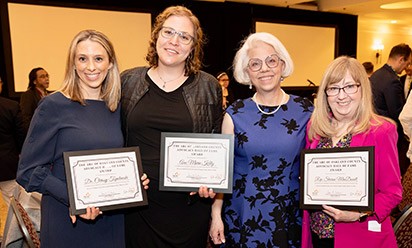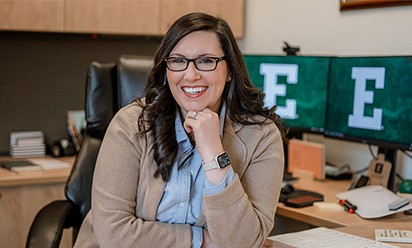Working remotely depends on technology, but don’t forget the human element: An interview with EMU associate professor Alankrita Pandey
EMU professor Alankrita Pandey knows from experience how empathy and the understanding perspective of your colleagues can help us navigate a new workplace reality

YPSILANTI – Experience in teaching online classes. Check.
Having a partner who has worked remotely for extended periods. Check.
Having a young child in the home. Check.
Alankrita Pandey, an associate professor in the Department of Management at Eastern Michigan University who teaches graduate classes in human resources, deeply understands the challenges in working from home. It’s a long-term task many around the country are confronting for the first time, other than perhaps a snow day or other brief work interruption.
In fact, before being interviewed for this story, Pandey had just finished a conference call of portfolio interviews for EMU’s master’s program in Human Resources and Organizational Development, the first time faculty had conducted that process remotely.
“Congratulations, and welcome to the dark side,” Pandey said of our new work situation.
Along with teaching face to face, Pandey has been teaching online at Eastern since 2014, the year after she began at EMU. She’s now well accustomed to the technology and personal dynamics of working remotely, and shared some of her recommendations:
High tech and low tech: Recognize in advance that the technology doesn’t always work as planned, or when you most need it. Sometimes, you must return to the old standards of email and, for anything complex, a phone call.
“Do send out mass emails (if needed),” Pandey says. “Sometimes students find it hard to log in. And with all the other changes taking place, lots of us are becoming stupid about our passwords. We have to understand these limitations.”
Get into a routine: It’s vital to establish a set daily schedule to get things done. Have set check-in times with your bosses or those who work for you. And it helps to even dress (casual day, of course) as if you are at work.
Get out: While COVID-19 means limits on social interaction, it still helps to see others while on a walk, to retain the sense of community that we are all in this together. Check out shared community forums, to see what others are feeling and experiencing.
Flexibility both a boon and bane: Working remotely means you can mute your computer and eat lunch while in a meeting. Yet it also means you are never quite off the clock in terms of answering calls, inquiries and the like, particularly if others you’re dealing with are on a different time schedule.
Set up a work space: Set up your own special work spot, in a different location from your partner’s. Have what you routinely need easily at hand.
Your co-workers are a source of support: Nobody understands your challenges better than colleagues, even if you have never met them extensively in person.
“Family and social support is important, but your co-workers understand the politics,” Pandey says. “They are the only ones that understand the dynamics of your department. We may not like them, but we need them. They get it.
“In fact, we need them now more than ever. They understand when we say, ‘This part of canvas is not working.’ Or when there’s problems with Zoom.”
For Pandey, the switch to working 100 percent remotely is a return to what she’s used to in her husband’s previous jobs, in which he’s interacted with colleagues around the world online. Yet she’s acutely aware of the varying level of technology access in different homes. Not everybody has the same kind of Internet access, where you can work on multiple devices at the same time.
“Technology is not a substitute for trying to understand each other,” Pandey says. “Students are people. That does not change. This is new, but it doesn’t have to be intimidating.”
And then there’s a final, furry silver lining: “Our dog is so happy these days,” Pandey says. “I have never seen her so content with her life. She is getting to meet us all the time.”
About Eastern Michigan University
Founded in 1849, Eastern is the second oldest public university in Michigan. It currently serves nearly 18,000 students pursuing undergraduate, graduate, specialist, doctoral and certificate degrees in the arts, sciences and professions. In all, more than 300 majors, minors and concentrations are delivered through the University's Colleges of Arts and Sciences; Business; Education; Engineering and Technology; Health and Human Services; and, its graduate school. EMU is regularly recognized by national publications for its excellence, diversity, and commitment to applied education. For more information about Eastern Michigan University, visit the University's website.
More Stories

Eastern Michigan University professor recognized on the 2024 Michigan Sports Hall of Fame Ballot for his love of sailing.

Eastern Michigan University professors receive Disability Advocacy Hall of Fame Award from The Arc of Oakland County Michigan.

Eastern Michigan University alumna, Aleksandra Efimova, leads self-made brand, RP to acquisition by renowned industry leader in dance footwear and apparel, Bloch.

Eastern Michigan University Vice President for Enrollment Management Katie Condon-Martin to help shed light on FAFSA “fiasco” as part of Bridge Michigan Zoom discussion on April 24.

Eastern Michigan University awards Summer Research and Creative Activity Grants.

